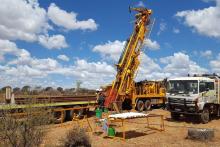Bellevue Gold has set a cracking pace this year, turning its namesake project near Leinster in WA back into a living breathing thing after most technocrats had written it off as a mined out deposit. The company’s market cap rocketed to around $300m after catching the market’s attention in 2017 when it went looking for a parallel gold lode adjacent to the historically mined Bellevue mine.


Bellevue Gold has set a cracking pace this year, turning its namesake project near Leinster in WA back into a living breathing thing after most technocrats had written it off as a mined out deposit. The company’s market cap rocketed to around $300m after catching the market’s attention in 2017 when it went looking for a parallel gold lode adjacent to the historically mined Bellevue mine.
The company has rounded out the 2019 year in style with eight rigs consistently pumping out a solid suite of impressive results.
Latest numbers include 3.4 metres grading 11.9 grams per tonne gold from 99.4m downhole from the Bellevue Lode Extensions.
Other impressive results include 2.3m at 39g/t gold from 819m, 3m at 10.4 g/t from 587.5m and 3m at 12g/t from 571m downhole at the new Deacon discovery.
Other shallower numbers of note from the Bellevue Lode Extensions include 2.8m at 46.9 g/t from 175m, 3.7m at 9.9 g/t from 140m and 2.5m at 22.4 g/t from 116m
Soon after its 2017 emergence, Bellevue tabled a half million-ounce maiden resource from a gold system that spanned around 800m in length.
Various successful drilling campaigns have now identified a remarkable four new mineralised lodes over a combined length of nearly two kilometres and a global resource that is just shy of two million ounces.
Good drill planning at Bellevue discovered the new Tribune, Viago, Vlad and Deacon lodes, all of which continue to show consistently good grades and conform nicely to the company’s predictive geological model of a “conjugate shear” hosted gold system.
Recently on the way through to the Deacon lode, a couple of drill holes intersected another zone named the Mavis lode, which sits about 40m below Deacon.
Conjugate shears or “cross-cutting” shears have certain geometric characteristics and particular intersection angles. Geologists can combine physical measurements of shears from the drill core and project the direction that these features head in order to define drill targets.
To firm up the placement of holes, Bellevue has been employing downhole electromagnetic surveying or “DHEM” – this geophysical tool is used to detect conductive material, usually massive sulphides, that may be lurking in proximity to the drill holes.
The gold systems at Bellevue are strongly associated with sulphide minerals and the company has found a very good correlation with the DHEM modelled conductive zones and high-grade gold mineralisation.
The Bellevue project is located around 30 kilometres north of Leinster in WA’s Eastern Goldfields region was previously mined between 1969 and 1997, producing 800,000 ounces from ore grading 15g/t, thereby proving itself to be one of the most profitable gold mines in Australia.
All four of the new gold lodes at Bellevue are located within a stone's throw of the historic Bellevue mine’s underground development which potentially opens up a number of less expensive options for accessing them via the old underground.
Bellevue Managing Director Steve Parsons said: …”Early site works have commenced to establish the required infrastructure to dewater the Bellevue mine, with dewatering scheduled to commence in first quarter 2020.”
An added advantage of accessing the new lodes via the old underground workings is that the company may be able to pull out any gold-bearing ore that was left behind by previous miners who were clearly focussed on the super high grades of the day.
Bellevue looks well placed to make the leap from explorer to producer into the new year and beyond and will take its place amongst a spate of hopefuls who are looking to breathe life into old mines that still have a few gifts to give.
Is your ASX listed company doing something interesting ? Contact : matt.birney@businessnews.com.au














